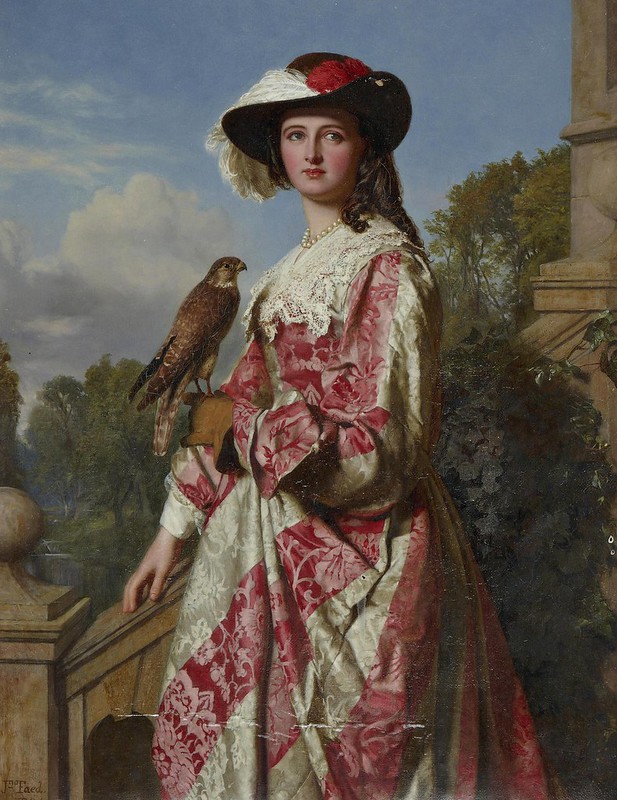Obra de John Faed (1819-1902), pintor escocès (1)
- Recordatori de Jean-Louis Tulou -
En el marc de la commemoració del seu 150è aniversari de decés
Parlem de Pintura...
John Faed, R.S.A. (Burley Mill, 31 d'agost de 1819 - Ardmore, 22 d'octubre de 1902) va ser un pintor escocès. Germà del gravador James Faed, es va formar inicialment a Edinburgh on va estudiar dibuix i pintura a l'acadèmia The Trustees. Va viatjar per Anglaterra abans d'instal·lar-se durant un temps a Londres on el seu germà Thomas Faed havia assolit considerable fama. Es va dedicar a pintura escènica molt relacionada amb la poesia d'autors escocesos tot i que també va abordar pintura religiosa, paisatgística i retrats. Va ser considerablement productiu amb més de 250 obres. Els darrers anys va tornar a Escòcia, on va morir l'octubre de 1902.
Font: En català: No disponible - En castellano: No disponible - In english: John Faed (1819-1902) - Altres: John Faed (1819-1902)
Parlem de Música...
Jean-Louis Tulou (Paris, 12 de setembre de 1786 - Nantes, 23 de juliol de 1865) va ser un flautista i compositor francès. Fill d'un mestre de fagot del Conservatori de París, va entrar a estudiar-hi als 10 anys. Alumne de Jean-Georges Wunderlich, el 1799 va guanyar el segon premi ja que per la seva joventut no li estava permès guanyar el primer premi. Dos anys després va obtenir-lo assolint la categoria d'un dels millors flautistes francesos del seu temps. Entre els anys 1815 i 1822 i des del 1826 fins la seva jubilació, es va convertir en el flautista principal de l'Òpera de París, on no va tenir rival possible. Va viatjar durant un temps a Londres on va ser rebut amb certa fredor per la seva rivalitat amb Drouet i Nicholson. El 1829 va assolir un càrrec al Conservatori de París que va mantenir fins el 1856. El 1831 va fundar un negoci de manufactura de flautes amb J. Nonon. Va viure la quasi totalitat de la seva vida a París si bé els darrers anys es va traslladar a Nantes, on va morir el juliol de 1865.
Font: En català: Jean-Louis Tulou (1786-1865) - En castellano: No disponible - In english: Jean-Louis Tulou (1786-1865) - Altres: Jean-Louis Tulou (1786-1865)
Parlem en veu pròpia o en veu d'altri...
GROVE MUSIC ONLINE (source/font: aquí)
---
Three composers can be heard on this recording: Jean-Louis Tulou (1786-1865) and two of his students, Jules Demerssemann (1833-1866) und Jean Donjon (1821-1912). Tulou and Demerssemann have left behind countless concertos and virtuosic solo pieces. In addition, it should be highlighted that between 1832 and 1860, every obligatory test piece for the yearly exam at the Paris Conservatoire was composed by Tulou. When selecting the music for this recording, however, these test pieces did not really come into consideration. Instead, we chose two types of piece: those composed for the music connoisseur, such as the Petite fantaisie poétique or the Boléro by Demerssemann; and those based on virtuosic opera arias, rewritten in 'simple' versions for flute and piano for performance in the Parisian salons, like Tulou's La Cavatine de Zelmira (in effect, a piano concerto with flute accompaniment) or Le café du roi. Demerssemann's L'hommage à Tulou ends in wild variations that contrast with the beautiful, unpretentious melodic lines, which fit Godfroy's flute well. Tulou's Duo Conertant op. 72 for two flutes mixes light music with serious passages that betray the influence of Beethoven. In the score of Demerssemann's Deuxième Sonate op. 23, the tempi, character and nuances are indicated with great precision, thus providing fascinating evidence for interpretation and playing style at that time, even if simultaneously restricting modernday artistic expression. Lastly, we have included some Etudes de salon et solos ou caprices pour la flûte seule by Jean Donjon, an advocate of the new Boehm flute and therefore a representative of the transition into the new era. In addition to the musical concerns which governed the selection of the repertoire, it was also important to me to interpret these works on a historical instrument, thus enabling me to explore the diverse sounds and complete tessitura of the instrument. Historical fingering charts preserved in contemporary flute tutors were also instructive.
ARKIVMUSIC Review (source/font: aquí)
Gaudiu i compartiu!
Informació addicional...
AMAZON: Jean-Louis Tulou et ses élèves: La flûte romantique à Paris
IMSLP: Jean-Louis Tulou (1786-1865)
CPDL: No disponible
SPOTIFY: No disponible


Un administrador del blog ha eliminat aquest comentari.
ResponElimina